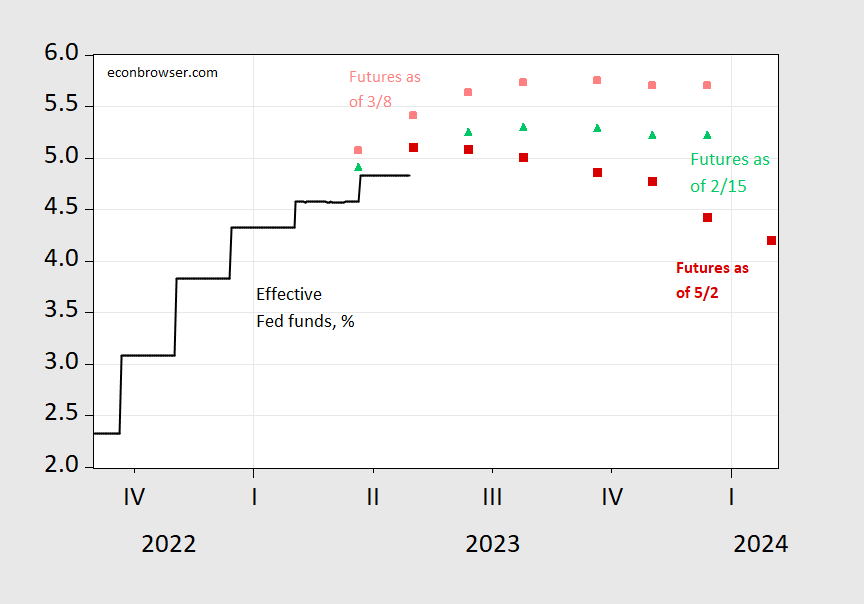According to the CME, peak Fed funds will be achieved tomorrow. So… “25 and done”…
Figure 1: Effective Fed funds (black), implied Fed funds as of May 2 5PM CT (red square), March 8, (pink square), February 15 (light green triangle). Source: Fed via FRED, CME Fedwatch and author’s calculations.
Between mid-February and early March, higher than expected inflation pushed up the expected trajectory of the Fed funds rate. After March 8, SVB and other banking woes have pushed down the anticipated trajectory.
The currently projected peak of 5/3 is earlier — and lower — than that of 9/20 anticipated in the March 8th futures. While this peak value is lower than the modal response of between 5.5%-6% in the mid-March FT-IGM survey, the timing (modal response of Q2) matches.

Hakeem Jeffries has just announced that House Democrats will attempt to use a discharge petition to force a House vote on a clean debt-ceiling increase:
https://democraticleader.house.gov/media/press-releases/dear-colleague-update-gop-manufactured-default-crisis
This would be one way for the GOP house leadership to get off the hook. Just a handful of GOP representatives would need to “defect” and they would take the blame.
Off topic, the “Fed put” examined:
https://www.richmondfed.org/publications/research/econ_focus/2023/q1_federal_reserve
An interesting claims is cited, that the put isn’t evident until after 1994. LTCM collapsed in 1998, so that could be the start.
One thing I don’t see is any mention of the relationship between stock market declines and overall financial market stress. There is a strong possibility that the the Fed put is triggered by fixed income market disruption and that poor stock market performance is naturally coincident with fixed income disruption.
Brain stimulating stuff (like many things you bring up here).
Next two months will be interesting. Let’s hope not in the panic attack kind of way. Interesting how quickly Pelosi gave in to Hank Paulson’s pleas way back when and how differently Republicans act when the tables are turned, and on top of that, in a much less self-created way this time.
https://econbrowser.com/archives/2023/05/the-unexpected-compression#comment-298148
May 2, 2023
Isn’t that what we would expect from the development of China? Initially, China competed in low wage markets, putting pressure on lower skilled wages, at least in terms of wage gains. As China begins to reach middle income status, its low wage labor has been absorbed and it is increasingly competing on a price basis with higher skilled labor.
— Steven Kopits
[ Precisely so.
China has just produced the first F-class heavy-duty gas turbine; after 13 years of development a complete F-class heavy-duty gas turbine, 11 meters and 400 tonnes, with thousands of parts, all domestic. A large number of increasingly highly-skilled workers, for whom this is only a beginning; physicists, chemists, designers, engineers, fabricators… for whom there are already derivative projects such as Stirling engines even for the space station. ]
https://news.cgtn.com/news/2023-04-20/China-completes-thermoelectric-conversion-test-in-its-space-lab-module-1j9eDtaKDgQ/index.html
April 20, 2023
China completes thermoelectric conversion test in its space lab module
China’s space lab module Mengtian has successfully completed its Stirling thermoelectric conversion test in orbit.
The entire process was smooth and the performance exceeded expectations, the China Science Daily reported on Wednesday. The thermoelectric conversion efficiency under the same isothermal ratio reached the international advanced level.
The heat-to-electricity conversion tech involves two pistons in a cylinder moving at high frequency, which can convert thermal energy to electricity with relatively high efficiency and power density.
As a new technology of spacecraft power system, the Stirling thermoelectric converter boasts several advantages such as simple structure, high efficiency, light weight, fast start, minimal vibration and low noise. It can reduce the reliance on traditional solar power and has a broad application prospect in manned lunar landings or deep space exploration.
The development of the Stirling thermoelectric converter on China’s space station Tiangong was led by the China Academy of Space Technology, while researchers from the Shanghai Institute of Ceramics of the Chinese Academy of Sciences (SICCAS) developed the heater unit of the converter.
“The efficiency of the heater unit is the key to ensuring the operation and performance of the Stirling thermoelectric converter,” said Zhang Minghui, associate researcher at the SICCAS. The test aims to evaluate the possibility of power generation in space and measure the converter’s power generation efficiency.
Previous heaters usually reserved the heat inside, while the new heater allows the directional flow of heat, Zhang explained. It is strong enough to withstand the huge force of a launching rocket….
I don’t think there are banking woes. Crypto leveraged banks that barely blipped in 2019 mattered little to credit markets. The inflation fake out driven January was a bigger issue. Which was created by herding spending.